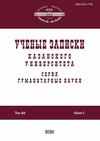Маркирование начала и конца слова в татарском языке: система гласных
Marking the Beginning and End of the Tatar Word: The System of Vowels
Author(s): A.M. Galieva, Zh. E. VavilovaSubject(s): Applied Linguistics, Phonetics / Phonology, Lexis, Cognitive linguistics, Turkic languages
Published by: Казанский (Приволжский) федеральный университет
Keywords: quantitative linguistics; Tatar language; word form boundaries; vocal structure of word form; chi-square test;
Summary/Abstract: In natural languages, segmentation of the speech flow is the most important aspect of speech decoding: the meaning of a linguistic whole can be understood only if it is broken down into smaller elements and these are combined according to the grammatical rules of the language. Thus, the marking of speech segments must be determined by the internal structure of the language. A necessary condition for defining the boundaries of such segments is the presence of cognitive mechanisms involved in the processes of decoding sign systems. For a number of reasons, certain difficulties arise when identifying the boundaries of word forms in the Tatar speech. Therefore, statistical studies on the phonological structure of the Turkic word form and on potential ways of marking its boundaries are of great scientific interest. Through studying the vocal structure of the word form with the allocation of vowel phonemes in the initial and final syllables, this article investigates how the beginning and end of Tatar words are marked at the level of vowels. Literary texts were used as the empirical material for this study. With the methods of mathematical statistics, it was demonstrated that the distribution of eight vowels in the first and last syllables has statistically significant differences. At the same time, only the phoneme ‹a›, which is roughly equally represented in the initial and final syllables, has two different (positionally marked) variants: ‹а о › (labialized ‹a›) in the first syllable and the usual ‹a› in all other syllables. This distribution of vowels enables Tatar speakers to correctly define the boundaries of word forms, along with stress and vowel harmony, which alone are not sufficient for a clear and unambiguous definition of the boundaries of word forms. The results obtained suggest that the statistically significant differences revealed in the distribution of vowel phonemes are of great cognitive importance for the perception and discrimination of signs because they mark the beginning and end of lexical units in the speech flow. In the future, the methodology developed in this work can be used for similar studies on other Turkic languages.
Journal: Ученые записки Казанского университета. Серия Гуманитарные науки
- Issue Year: 164/2022
- Issue No: 5
- Page Range: 130-140
- Page Count: 11
- Language: Russian

